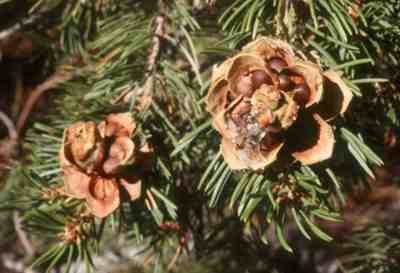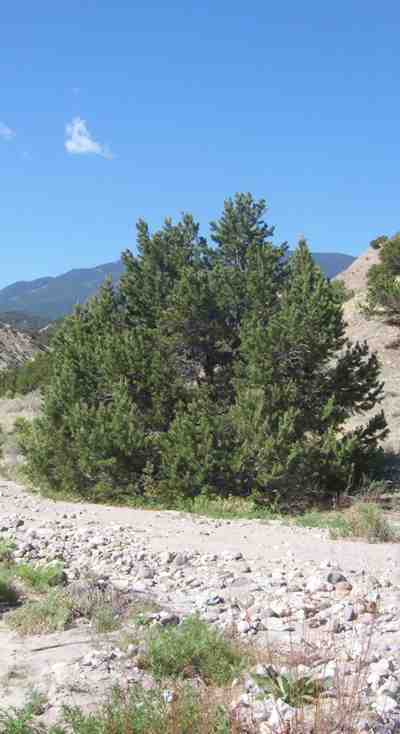Article by Dustin Heron Urban
Forests – July 2008 – Colorado Central Magazine
I WAS RECENTLY SNACKING on pine nuts, and the bag in which they were contained read “Pine nuts really do come from trees!” “How enlightening,” I thought to myself. “What if I cared to know what type of tree?” The ingredient list merely read: “pine nuts.” Although the name makes it quite plain that these buttery little vanilla-colored morsels come from pine trees, there are at least 24 commonly occurring members of the genus Pinus in the West and many more across the globe and at least 20 pine species produce nuts good for eating. There was no way for me to easily deduce which species of pine that bag of pine nuts came from, but come autumn, there will be no mistaking where my pine nuts are from: Pinus edulis, the Colorado Piñon.
The Colorado Piñon grows extensively in the Southern Rockies, usually from 5,000 to 7,000 feet in elevation. I say “usually” because from my home in Buena Vista, at an elevation of roughly 8,000 feet, I have a clear view of an extensive stand of piñons which blankets the contours of Midland Mountain to the east. But it’s not technically a “stand of piñons to my east.” More accurately the ecosystem in which this tree occurs is known as Piñon-Juniper Woodlands.

Piñons usually occur in conjunction with several variety of juniper. The most common at this elevation are Juniperus scopulorum, the Rocky Mountain Juniper and Juniperus monosperma, the Oneseed Juniper. In the southwest as a whole, several other juniper and piñon varieties comprise these “pygmy forests” (so-called for the small stature of both trees), which cover approximately 50 to 75 million acres, according to the U.S. Forest Service. Junipers are majestic trees with aromatic and resinous berries whose smell and flavor are familiar to those who have tasted gin. Native Americans used their wood and bark for numerous applications including firewood and cordage.
But it is the nut of the piñon for which this ecosystem is most notable. Pinus edulis can be quickly identified and distinguished from other pines by its needles which are ¾ to 1½ inches long and occur in bundles of two. Its cones grow at the tips of branches and take nearly three seasons to mature. At maturity, each cone holds from 10 to 20 seeds and a given tree can yield as much as 20 pounds of nuts. Crops are unpredictable, however, and a given stand of piñons will yield only one or two large harvests each decade with less bountiful crops occurring every several years. But every autumn about a third of piñon stands will have good crops.
Pine nuts have long been a staple of the Native Americans of the southwest who depended on them for winter sustenance and would travel extensively to find piñon stands with a good harvest. Early European explorers, including John C. Frémont, reported trading extensively with the Indians for this winter staple.
[InContentAdTwo]
SOME SCIENTISTS now believe that an isolated stand of edulis in Owl Canyon near Fort Collins actually originated from piñon seeds dropped by Native Americans traveling an ancient trade route between the piñon’s typical range and the northern plains region. The Owl Canyon stand is more than a hundred miles from the nearest piñons to the south. The most ancient of the trees are believed to be 400 years old and grow in close proximity to one another, suggesting a common origin from a pile of dropped seeds.
Early western settlers quickly developed a taste for this abundant and nutritious nut. During the 19th century caravans making use of the Camino Real between Santa Fé and Mexico City transported, among their many other valued items of commerce, pine nuts. To this day cars line the highways in piñon country during September and October as locals capitalize on the local bounty.
If all of this has you craving this nut whose taste Haniel Long, author of Piñon Country, describes as “Pine and sunshine and popcorn, and peanuts too in a way,” here are some harvesting tips. Pine nuts are mature by late August or early September, although the cones may not open and drop their seeds until some weeks later. A common method of collection is to wait until the cones have opened to the point that the nuts easily drop from them if disturbed. At this point you can spread a large blanket beneath the piñon of your choice, shaking the branches or tapping them with a pole in order to jar the seeds loose. The vanilla-colored nut will be encased in a brown shell. If the cones have not yet opened but it is after Labor Day, you can harvest the whole cones by twisting them until they break free of the branch. Do not break branches off the tree. If harvesting cones, spread them in a dry place at home and they should open and release their nuts within a week or so.

Once you have amassed a cache of nuts, leave them in their shell if you intend to store them. Place them in a dry and ventilated location or you can seal them in a jar if they are allowed to dry sufficiently. They should keep for two to three years using this method. If frozen, pine nuts can be stored indefinitely.
When you are ready to eat the nuts, you have several options for removing the hard, outer shell. You can either crack the nuts between your teeth, taking care not to do any dental damage, or you can use pliers, a nut cracker, a rolling pin or some similar tool to break the outer shells without crushing the tender meat inside.
At this point you are free to enjoy the flavor and nutritional value of this ancient food from our local land. Ronald M. Lanner, author of The Piñon Pine: A Natural and Cultural History, reports that pine nuts were such an effective staple food for the Native Americans largely because of their excellent nutritional value. Pine nuts from Pinus edulis contain 14% protein, 62-71% fat, and 18% carbohydrates. Their protein contains all 20 of the amino acids, and “One pound of shelled Colorado Piñon nuts provides 2,880 calories, more than the food energy in a pound of chocolate, and nearly as much as in a pound of butter. The biologic value of its protein exceeds that of all commercial nuts but the cashew and is comparable to that of beefsteak.”
IF YOU’RE WONDERING about the quality of the upcoming harvest, there is little I can report with certainty, but an official at the Salida office of the Forest Service told me that he expects this year’s piñon crop to be “at least average, maybe a little above average.” He estimates that the moisture we experienced last winter should contribute to a good crop, although there is always the risk that insects will get to the crop before humans. In my locale, the piñons are exhibiting small, immature cones which should develop to mature, seed-bearing cones by fall. With any luck we’ll have a good harvest and pine nuts in storage until the next crop comes around two or three years from now.
I’m excited to partake of the local bounty come fall. It seems rather fortunate that we live in a region where such a widespread tree species produces such a tasty crop. I hope the piñons in my back yard will offer up a good harvest, but if they do not, I plan to find a stand that will. I find a real sense of connection with the land in gathering wild foods, and I look forward to continuing the long tradition in the west of subsisting (at least in part) through the winter on pine nuts. Plus, I won’t have to settle for the inane statement “Pine nuts really do come from trees!” There will be no doubt where my pine nuts come from: Pinus edulis, the Colorado Piñon.
Dustin Urban writes from Buena Vista.


